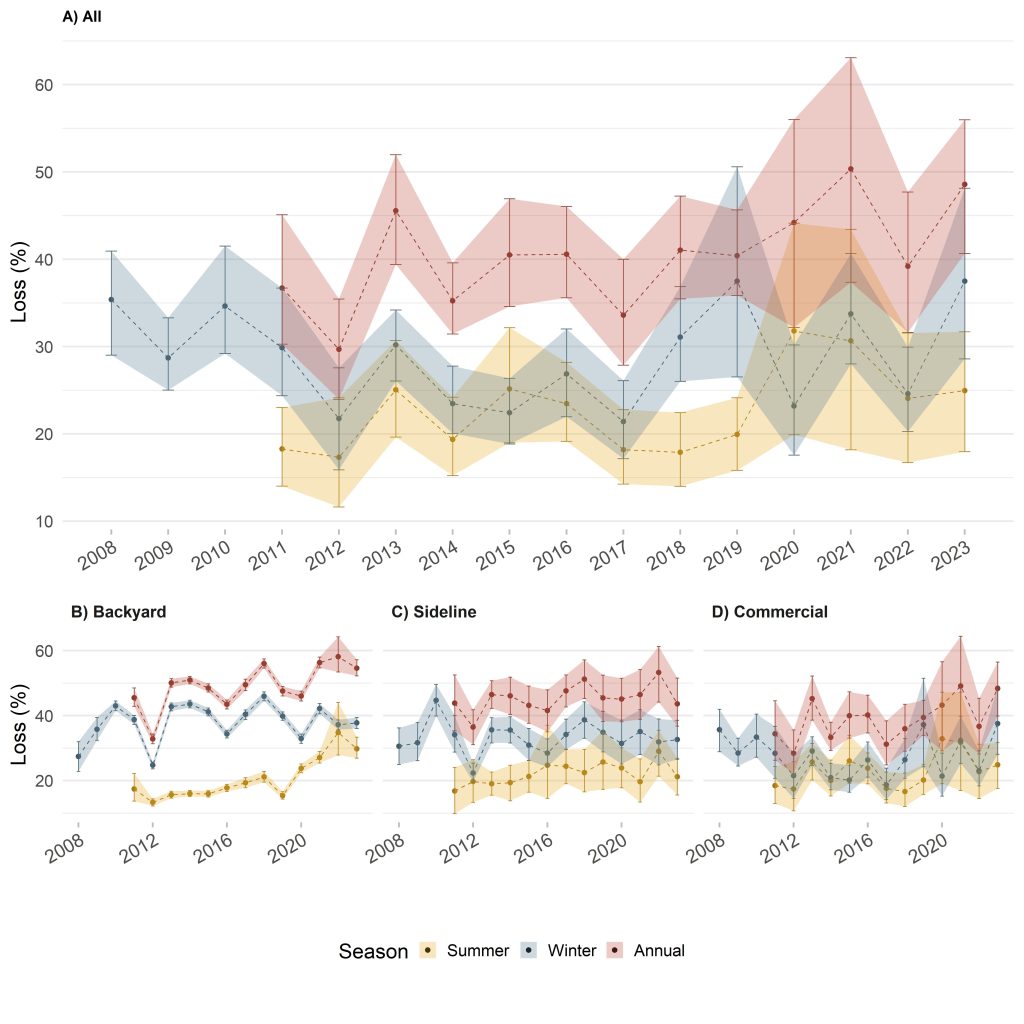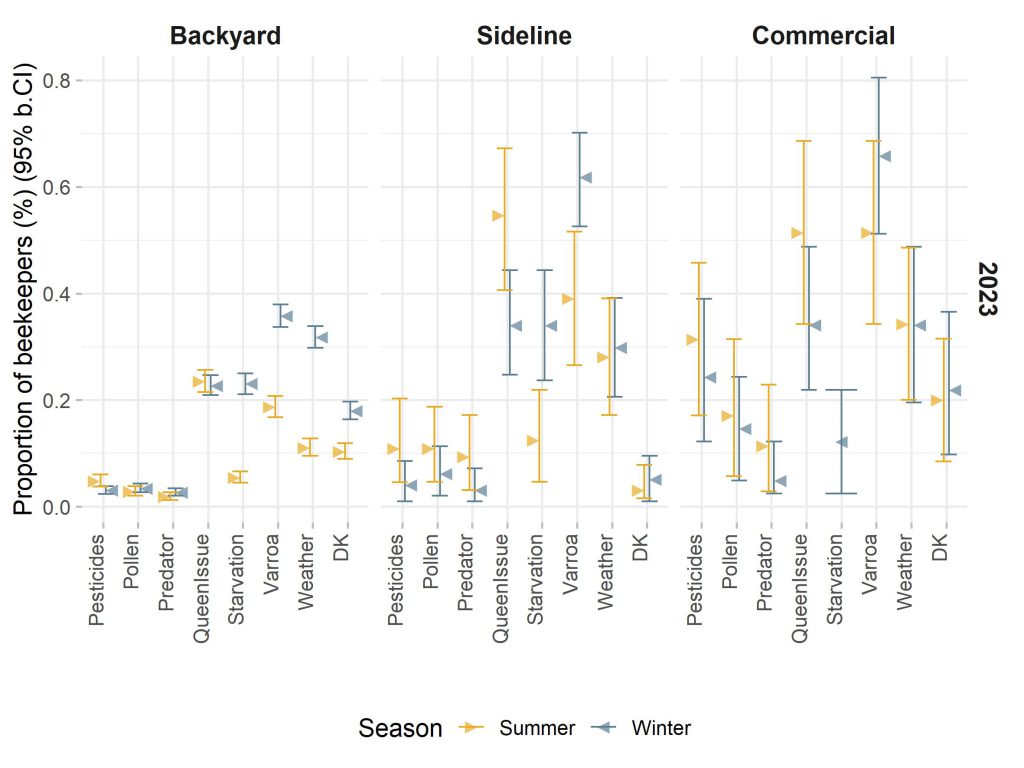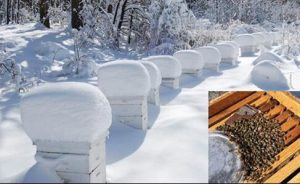United States Honey Bee Colony Losses 2022-2023:
Preliminary Results from the Bee Informed Partnership
By: Nathalie Steinhauer, Mikayla Wilson, Dan Aurell, Selina Bruckner, Geoffrey Williams
Note: This is a preliminary analysis. Sample sizes and estimates are likely to change. A more detailed final report is being prepared for publication in a peer-reviewed journal at a later date. Previous years’ peer-reviewed publication can be accessed on the survey information page: https://beeinformed.org/citizen-science/loss-and-management-survey/.
The Bee Informed Partnership (http://beeinformed.org) is a non-profit organization that strives to improve honey bee colony health in the United States by performing data-driven research in collaboration with beekeepers. Its vision is to create an environment where new and established beekeepers can be successful in maintaining healthy honey bee colonies. One of the organization’s longest running programs, the national Colony Loss and Management Survey, was initiated with the support of the Apiary Inspectors of America in 2007. Since then, it has monitored colony loss rates of managed honey bees in the United States (Bruckner et al., 2023), as well as identified risk factors and protective measures associated with health, particularly as they relate to beekeeping management (Steinhauer, vanEngelsdorp and Saegerman, 2021). The survey is organized in collaboration with the Bee Lab at Auburn University (https://aub.ie/bees) and the Bee Lab at University of Maryland (https://www.umdbeelab.com/).

Figure 1. Seasonal managed honey bee colony loss rates in the United States across years (A), and by operation type (B-D): backyard (managing up to 50 colonies), sideline (managing 51-500), and commercial (managing >500 colonies) beekeepers. The loss rate was calculated as the total number of colonies lost divided by the number of colonies at risk during the season. Colonies at risk were composed of living colonies at the start of a period, as well as new colonies made or acquired, while excluding colonies sold or parted with. Annual loss covers the whole period from one 1 April to the next 1 April (in red); Summer (1 April – 1 October, in yellow); Winter (1 October – 1 April, in blue). Error bars represent the 95% confidence interval obtained from a bootstrap resampling of the data (n-out-of-n, 1000 rep).
The survey is a retrospective online questionnaire, which relies on voluntary participation of beekeepers across the country during the month of April. The 2023 survey covered the one year period between April 2022 and April 2023. Small scale beekeepers (1-50 colonies) and large-scale beekeepers (>50 colonies) took slightly different versions of the survey (survey question previews can be found at https://beeinformed.org/citizen-science/loss-and-management-survey/).
This year, 3,006 beekeepers from across the United States provided valid survey responses. These beekeepers collectively managed 314,360 colonies on 1 October 2022, representing 12% of the estimated 2.70 million managed honey-producing colonies in the country in 2022 (USDA NASS, 2023).
Colony loss rates were calculated as the ratio of the number of colonies lost to the number of colonies managed over a defined period. Loss rates should not be interpreted as a change in population size, but are best interpreted as a mortality rate. High levels of losses do not necessarily result in a decrease in the total number of colonies managed in the United States because beekeepers can replace lost colonies throughout the year.
During Summer 2022 (1 April 2022 – 1 October 2022), an estimated 24.9% [18.0 – 31.7, 95% bootstrapped confidence interval (CI) (Confidence intervals were obtained from the distribution of bootstrapped estimates for each group of respondents (n-out-of-n method, 1000 rep). Due to the stochastic nature of bootstrap analyses, 95% CI are expected to vary slightly at each computation.)] of managed colonies were lost in the United States (Fig. 1). This was on par with recent years. The Summer loss rate was just 1.1 percentage point (pp) higher than last year’s estimated Summer colony loss (23.8% [16.7 – 31.5 CI]), and 2.2 pp higher than the average Summer loss reported by beekeepers since the Summer of 2010 (22.6%, 12-year average), when Summer losses were first monitored.
During Winter 2022-2023 (1 October 2022 – 1 April 2023), an estimated 37.4% [28.6 – 48.1 CI] of managed colonies in the United States were lost (Fig. 1). This Winter loss rate was 13.2 pp in excess of the previous Winter loss rate (24.2% [20.3 – 29.9 CI]), and 9.1 pp higher than the average Winter loss (28.2%, 15-year average) reported by beekeepers since the start of the survey in 2008, making 2022-2023 the second highest year of Winter loss after 2018-2019 (37.7% [26.5 – 50.6 CI]). The percentage of colony loss over the Winter deemed “acceptable” by beekeepers was on average 21.3% in 2022-2023, which was on par with the previous nine years during which the acceptable loss has hovered around 20%. In 2022-2023, over 60% of the surveyed beekeepers reported Winter loss above this threshold.
Over the entire year (1 April 2022 – 1 April 2023), beekeepers in the United States lost an estimated 48.2% [40.7 – 56.0 CI] of their managed honey bee colonies (Fig. 1). This was 9.2 pp higher than last year’s estimated annual loss (39.0% [31.6 – 47.7 CI]), nearly as high as (2.6 pp lower than) the highest annual loss on record (2020-2021, 50.8% [37.4 – 63.1 CI]), and 8.5 pp higher than the average loss rate (39.6%, 12-year average) over the last 12 years.

Figure 2. Self-reported causes of colony loss over Summer 2022 (1 April – 1 October, in yellow) and Winter 2022-23 (1 October – 1 April, in blue), as reported by U.S. beekeepers grouped by operation type: backyard (managing up to 50 colonies), sideline (managing 51-500), and commercial (managing >500 colonies). Number of respondents: backyard (Summer: 1,495, Winter: 2,070), sideline (Summer: 64, Winter: 97) and commercial (Summer: 35, Winter 41) beekeepers. The arrow represents the proportion of beekeepers having selected the specific cause of loss in a list of multiple choices associated with the question: “What factors do you think were the most prominent cause(s) of colony death in your operation in [season]?”. Errors bars represent the 95% confidence interval obtained from a bootstrap resampling of the data (n-out-of-n, 100 rep). Legend: Pesticides (Non-apicultural pesticides); Pollen (Nutritional stress (pollen deprivation)); Predators (e.g. bears); Queen issues; Starvation (honey/nectar/sugar water); Varroa (varroa mites and associated viruses); Weather (adverse weather (e.g. drought, cold snap)); DK (Don’t know). Answers selected by less than 10% of respondents in all three groups are not shown. Other multiple choice options not listed in the figure: Brood diseases (e.g. AFB, EFB), Natural disaster (e.g. hurricane, flood), Apicultural treatments (e.g. formic acid, amitraz), Shipping stress (e.g. overheating, truck issues). Equipment failure (e.g. moisture, ventilation), Failure of environmental controls in sheds, Scavenger pests (e.g. small hive beetle, wax moth).
As in previous years, backyard beekeepers experienced a higher annual rate of loss than commercial beekeepers in 2022-2023 (54.6% [52.2 – 57.2 CI] for backyard vs 47.9% [39.9 – 56.4 CI] for commercial). This represented a higher loss year than average for both backyard beekeepers (5.8 pp more than their 12-year average of 48.8%) and commercial beekeepers (9.7 pp more than their 12-year average of 38.2%), but it seems issues occurred at different times of the year for the two groups.
Backyard beekeepers again experienced one of their highest Summer losses on record (the last four years classified as the top four, three, one and two, respectively, in the 13-year record), with 29.8% Summer 2022 loss [26.9 – 33.4 CI], this was 10.0 pp over the previous 12-year average of 19.8%. Commercial beekeepers reported Summer losses (24.7% [17.6 – 31.7 CI]) on par (1.8 pp over) with their average over the previous 12 years (22.8%).
Though the loss rates of both groups were comparable for the Winter season (37.8% [36.0 – 39.4 CI] for backyard beekeepers, and 37.6% [28.1 – 49.1 CI] for commercial beekeepers), this represented a high loss season for the commercial group (10.7 pp over their 27.0% 15-year average), but an average season for backyard beekeepers (0.2 pp lower than their 38.0% 15-year average). Such high Winter loss rates for commercial beekeepers have only been reported once before in this survey, in 2018-2019.
The most prominent cause of colony death reported by beekeepers over the Winter 2022-23 was “varroa” (Varroa destructor, and its associated viruses), for all three operation types (Fig. 2). Backyard beekeepers then tended to cite “adverse weather” and “starvation” (meaning lack of honey, nectar, or sugar water) as the second and third most prominent causes of Winter colony loss in their operations. Sideline beekeepers equally cited “queen issues” and “starvation” as their second most prominent cause of Winter loss. Commercial beekeepers cited equally “queen issues” and “adverse weather”.
In the Summer of 2022, the most prominent cause of colony death reported by beekeepers of all operation types was “queen issues” (Fig. 2). Both backyard and sideline beekeepers then listed “varroa” and “adverse weather”. Commercial beekeepers cited “varroa” as frequently as “queen issues” as their most prominent causes of loss over the Summer, followed by “adverse weather”.
Although the total number of honey bee colonies in the country has remained relatively stable over the last 20 years (~2.6 million colonies according to the USDA NASS Honey Reports), loss rates remain high, indicating that beekeepers are under substantial pressure to recover from losses by creating new colonies every year. The Bee Informed Partnership’s annual Colony Loss and Management Survey offers an important record of such loss rates experienced by beekeepers across the United States each year. Until the survey was launched in 2007, there was no rigorous record of loss rates of managed honey bee colonies, making it difficult to compare losses against historic levels.
To obtain more information about Bee Informed Partnership’s annual national Colony Loss and Management Survey, visit: https://beeinformed.org/citizen-science/loss-and-management-survey/.
State level estimates, including estimates for single-state and multi-state operations, will be published on https://research.beeinformed.org/loss-map/.
Authors
Nathalie Steinhauer – Department of Entomology, University of Maryland, College Park, MD, USA and Bee Informed Partnership, College Park, MD, USA
Mikayla Wilson – Department of Entomology, University of Maryland, College Park, MD, USA and Bee Informed Partnership, College Park, MD, USA
Dan Aurell – Department of Entomology & Plant Pathology, Auburn University, Auburn, AL, USA
Selina Bruckner – Department of Entomology & Plant Pathology, Auburn University, Auburn, AL, USA
Geoffrey Williams – Department of Entomology & Plant Pathology, Auburn University, Auburn, AL, USA
Corresponding authors: nsteinha@umd.edu (NS) & williams@auburn.edu (GW)
References cited
Bruckner, S., Wilson, M., Aurell, D., Rennich, K., vanEngelsdorp, D., Steinhauer, N. and Williams, G.R. (2023) ‘A national survey of managed honey bee colony losses in the USA: results from the Bee Informed Partnership for 2017–18, 2018–19, and 2019–20’, Journal of Apicultural Research, 62(3), pp. 429–443. Available at: https://doi.org/10.1080/00218839.2022.2158586.
Steinhauer, N., vanEngelsdorp, D. and Saegerman, C. (2021) ‘Prioritizing changes in management practices associated with reduced winter honey bee colony losses for US beekeepers’, Science of The Total Environment, 753, p. 141629. doi: https://doi.org/10.1016/j.scitotenv.2020.141629
USDA NASS (2023) Honey (March 2023). ISSN: 1949-1492. Available at: https://usda.library.cornell.edu/concern/publications/fq977t78v?locale=es (Accessed 16 June 2023).
Previous survey results
Aurell, D., Bruckner, S., Wilson, M., Steinhauer, N., Williams, G., for the Bee Informed Partnership (2022). United States Honey Bee Colony Losses 2021-2022: Preliminary Results. https://beeinformed.org/2022/07/27/united-states-honey-bee-colony-losses-2021-2022-preliminary-results-from-the-bee-informed-partnership/ (Accessed 16 June 2023).
Steinhauer, N., Aurell, D., Bruckner, S., Wilson, M., Rennich, K., vanEngelsdorp, D., Williams, G., for the Bee Informed Partnership (2021). United States Honey Bee Colony Losses 2020-2021: Preliminary Results. https://beeinformed.org/wp-content/uploads/2021/06/BIP_2020_21_Losses_Abstract_2021.06.14_FINAL_R1.pdf (Accessed 16 June 2023).
Kulhanek, K., Steinhauer, N., Rennich, K., Caron, D. M., Sagili, R. R., Pettis, J. S., Ellis, J. D., Wilson, M. E., Wilkes, J. T., Tarpy, D. R., Rose, R., Lee, K., Rangel, J. and vanEngelsdorp, D. (2017) ‘A national survey of managed honey bee 2015–2016 annual colony losses in the USA’, Journal of Apicultural Research, 56(4), pp. 328–340. https://www.tandfonline.com/doi/full/10.1080/00218839.2017.1344496.
Lee, K. V., Steinhauer, N., Rennich, K., Wilson, M. E., Tarpy, D. R., Caron, D. M., Rose, R., Delaplane, K. S., Baylis, K., Lengerich, E. J., Pettis, J., Skinner, J. A., Wilkes, J. T., Sagili, R., vanEngelsdorp, D. and Partnership, for the B. I. (2015) ‘A national survey of managed honey bee 2013–2014 annual colony losses in the USA’, Apidologie, pp. 1–14. https://link.springer.com/article/10.1007/s13592-015-0356-z.
Seitz, N., Traynor, K. S., Steinhauer, N., Rennich, K., Wilson, M. E., Ellis, J. D., Rose, R., Tarpy, D. R., Sagili, R. R., Caron, D. M., Delaplane, K. S., Rangel, J., Lee, K., Baylis, K., Wilkes, J. T., Skinner, J. A., Pettis, J. S. and vanEngelsdorp, D. (2015) ‘A national survey of managed honey bee 2014–2015 annual colony losses in the USA’, Journal of Apicultural Research, 54(4), pp. 292–304. https://www.tandfonline.com/doi/full/10.1080/00218839.2016.1153294.
Spleen, A. M., Lengerich, E. J., Rennich, K., Caron, D., Rose, R., Pettis, J. S., Henson, M., Wilkes, J. T., Wilson, M., Stitzinger, J., Lee, K., Andree, M., Snyder, R., vanEngelsdorp, D., and for the Bee Informed Partnership (2013) ‘A national survey of managed honey bee 2011–12 winter colony losses in the United States: results from the Bee Informed Partnership’, Journal of Apicultural Research, 52(2), pp. 44–53. https://www.tandfonline.com/doi/abs/10.3896/IBRA.1.52.2.07.
Steinhauer, N. A., Rennich, K., Wilson, M. E., Caron, D. M., Lengerich, E. J., Pettis, J. S., Rose, R., Skinner, J. A., Tarpy, D. R., Wilkes, J. T. and vanEngelsdorp, D. (2014) ‘A national survey of managed honey bee 2012-2013 annual colony losses in the USA: results from the Bee Informed Partnership’, Journal of Apicultural Research, 53(1), pp. 1–18. https://www.tandfonline.com/doi/abs/10.3896/IBRA.1.53.1.01.
vanEngelsdorp, D., Caron, D., Hayes, J., Underwood, R., Henson, M., Rennich, K., Spleen, A., Andree, M., Snyder, R., Lee, K., Roccasecca, K., Wilson, M., Wilkes, J., Lengerich, E. and Pettis, J. (2012) ‘A national survey of managed honey bee 2010-11 winter colony losses in the USA: results from the Bee Informed Partnership’, Journal of Apicultural Research, 51(1), pp. 115–124. https://www.tandfonline.com/doi/abs/10.3896/IBRA.1.51.1.14.
vanEngelsdorp, D., Hayes, J., Underwood, R. M., Caron, D. and Pettis, J. (2011) ‘A survey of managed honey bee colony losses in the USA, fall 2009 to winter 2010’, Journal of Apicultural Research, 50(1), pp. 1–10. https://www.tandfonline.com/doi/abs/10.3896/IBRA.1.50.1.01.
vanEngelsdorp, D., Hayes, J., Underwood, R. M. and Pettis, J. (2008) ‘A Survey of Honey Bee Colony Losses in the U.S., Fall 2007 to Spring 2008’, PLoS ONE, 3(12). https://journals.plos.org/plosone/article?id=10.1371/journal.pone.0004071.
vanEngelsdorp, D., Hayes, J., Underwood, R. M. and Pettis, J. S. (2010) ‘A survey of honey bee colony losses in the United States, fall 2008 to spring 2009’, Journal of Apicultural Research, 49(1), pp. 7–14. https://www.tandfonline.com/doi/abs/10.3896/IBRA.1.49.1.03.
vanEngelsdorp, D., Underwood, R., Caron, D. and Hayes, J. (2007) ‘An estimate of managed colony losses in the winter of 2006-2007: A report commissioned by the apiary inspectors of America’, American Bee Journal, 147(7), pp. 599–603.









